If you’re visiting Nigeria as a tourist or want to savor Nigerian dishes prepared at African restaurants in your area, we’ve compiled a list of the most delectable dishes to explore.
Nigerian meals have recently been addressed on a global scale, which can be due to the excitement surrounding the sumptuous flavor of her various soups, stews, and staple foods. Is Nigerian cuisine deserving of its reputation? You’ll find out soon enough.
After reading this list, we urge that you attempt making some of these if you have access to the ingredients. There are also Nigerian restaurants in the United States that provide these meals.
Jollof Rice King in Texas, Festac grill and Buka in New York, Miya Lounge in Maryland, Abeke’s kitchen in Grays Avenue, Lagos Spot in New Jersey, Nigerian Kitchen in Chicago, and many others are among the popular Nigerian eateries in the United States.
Everything you need to know about the most popular dishes and their recipes can be found in this article. Let us take you on a food tour through Nigeria.
20 Nigerian Foods You Need to Try
This is a list of 20 of Nigeria’s most popular foods. With these dishes, your taste buds are in for a treat.
1. Swallow Dishes
Swallow foods are the most popular traditional Nigerian cuisines. Swallows are thick, solid meals that are eaten with soups and stews and are ingested by swallowing rather than chewing. Eba (cassava flour), Amala (yam flour), Iyan (pounded yam), Fufu, and Semo (Corn Flour) are the most regularly consumed swallows.
I. Eba (Cassava Meal)
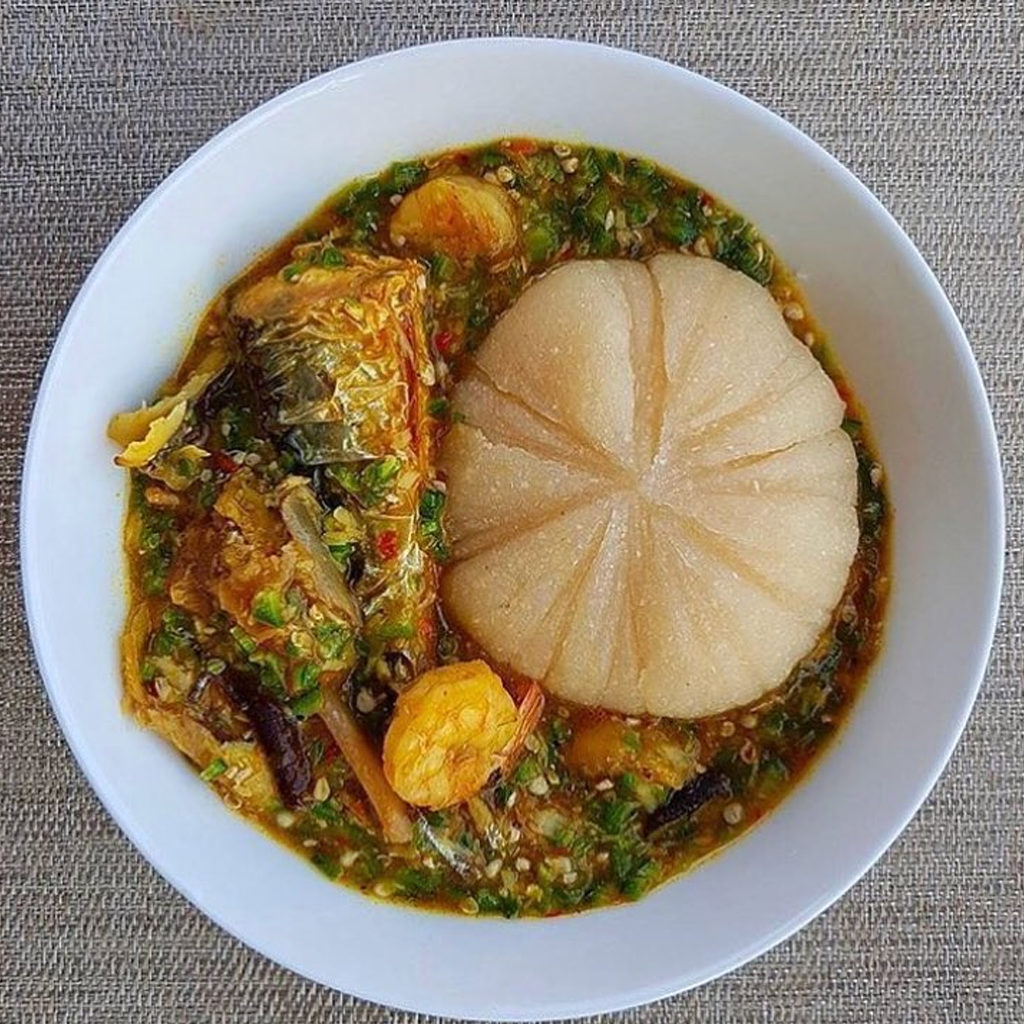
Eba is made by mixing Garri with hot water. Garri is a cassava-based processed food. Amala is a combination of Yam flour and hot water. In Nigeria, we have white Eba and yellow Eba. Yellow Eba is made from cassava flour mixed with palm oil. Yellow Eba is commonly eaten by the eastern people of Nigeria.
II. Iyan (Pounded Yam)
Iyan is made from mashing yam slices and hot water, but there is yam flour which can be combined with hot water; the latter is the easier option.
III. Semo
Semo is a mixture of corn and cassava flour combined with hot water. When properly prepared, smooth dough balls are formed.
Iv. Fufu (Yam Flour Meal)
Fufu is made from cassava flour, although it requires a different technique to make Garri. These swallows are traditionally eaten with the hands; however, they can also be eaten with cutlery.
These swallows are frequently served with delectable Nigerian soups. Swallows make the most of Nigerian main course dishes and are often served in Nigerian homes for lunch and dinner. Major meals eaten at Nigerian parties and festivities are swallow dishes.
2. Efo riro (Vegetable soup)

In Nigeria, Efo-riro is one of the most popular vegetable soups. It is a Yoruba soup native to western Nigeria, but it is also enjoyed by other areas across the country. This delicacy is often prepared with African spinach leaves and fluted pumpkin (Ugu).
Vegetable leaves, blended pepper, spices, palm oil, meat, fish, and stock are used to make Efo-riro.
This tasty soup goes well with Eba (cassava flour), Semo, Iyan (pounded yam), Rice, and even boiled plantains (whether ripe or unripe). Efo-riro is a simple dish to make and is a popular delicacy in African restaurants around the United States.
It is also a popular dish at Nigerian parties and restaurants. Efo-riro is a nutritious soup that is high in vitamins and has numerous health advantages. You can make your Efo-riro as soon as you get your hands on the ingredients.
3. Ewedu (Jute leaf Soup)
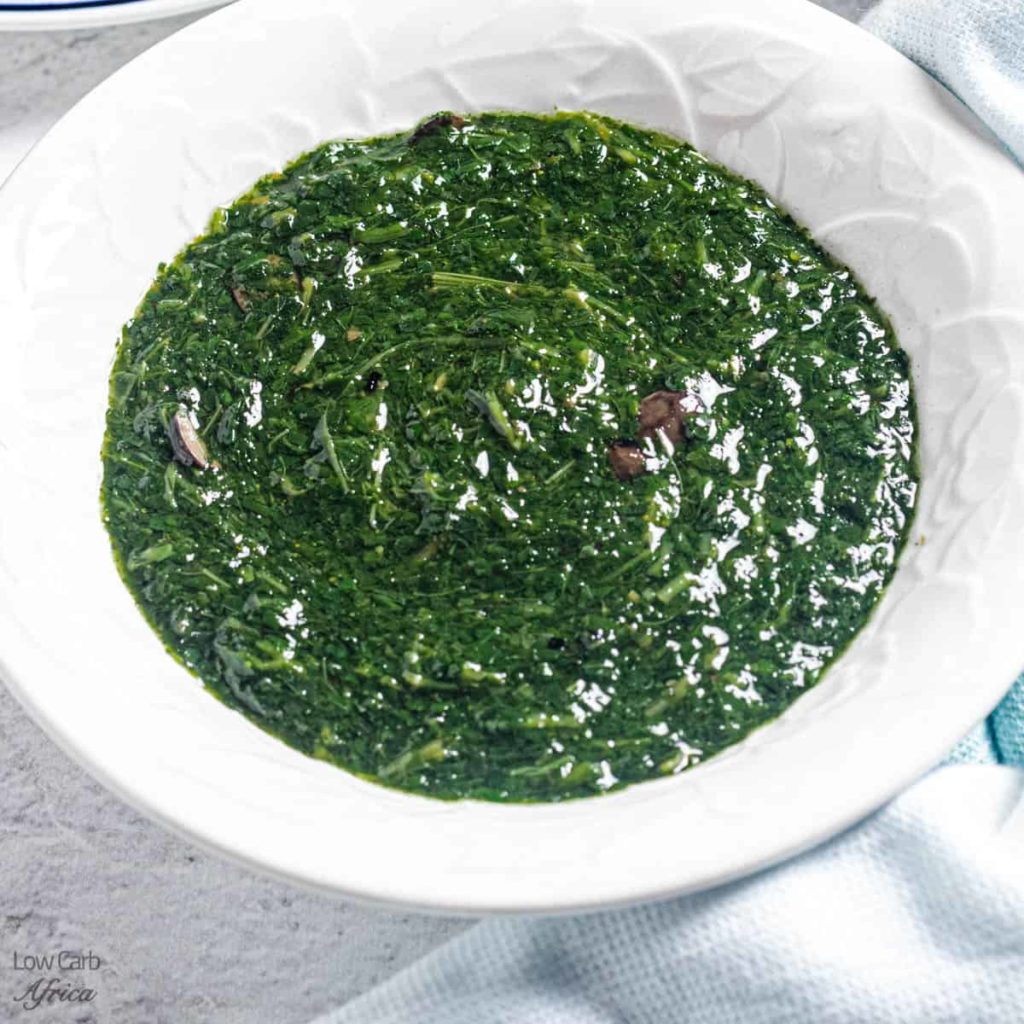
Another popular Nigerian soup is Ewedu, which is Yoruba in origin. Ewedu is a slimy green soup that is one of the simplest Nigerian soups to make.
Ewedu soup is created with jute leaves combined with water, iru (locust beans), and salt. Ewedu soup, unlike other Nigerian soups, cannot be eaten on its own since it is not as tasty. It is best combined with stew or Gbegiri soup.
Also, Ewedu soup is a common dish at Nigerian parties and her local restaurants. It is commonly eaten with Amala, Eba, and Semo. Ewedu is high in nutrients because it has a good amount of fiber, which aids in bowel movement and improves gastrointestinal health.
4. Abula – (Bean soup with draw vegetable soup and stew)
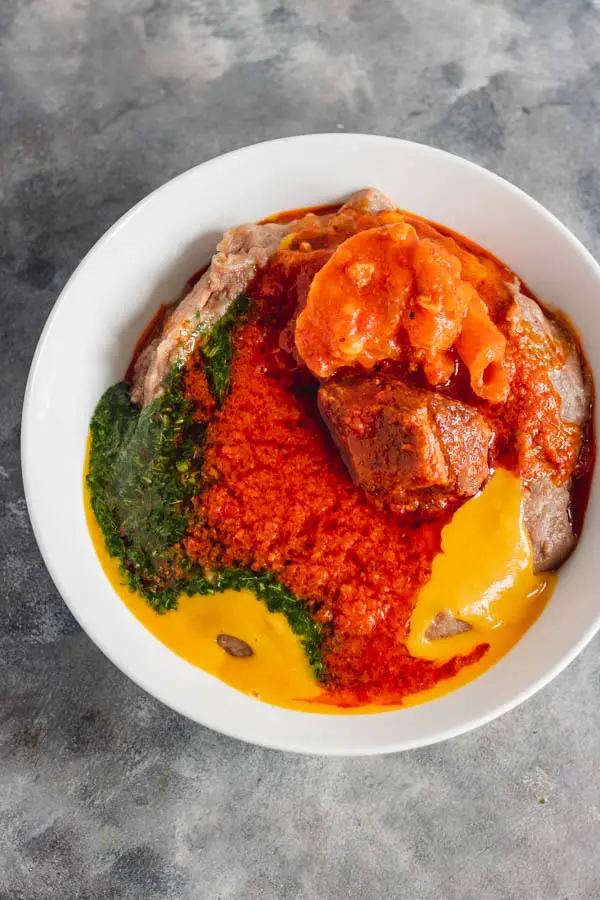
What is a Nigerian ceremony without Abula? Abula is arguably the most desired dish in western Nigerian parties and restaurants. Abula is a mix of Ewedu soup(bean soup), Ewedu (draw vegetable soup), and ọbẹ̀ ata (stew). It is best eaten with Amala (Yam Flour) but can be eaten with other swallowed foods.
This dish takes a considerable amount of time to prepare, but it’s well worth the effort and excitement. Your taste buds would never recover from this delicious meal. Abula is best enjoyed when it contains varieties of assorted meat. If you are on a tour in Nigeria, this dish is a must-have.
5. Obe Ila (Okra Soup)
Okro soup is a common delicacy eaten by the Yoruba and Igbo people of Nigeria. Okra soup is a popular dish in Nigeria because it is very easy to prepare. There are two kinds of Okro soup- Obe Ila and Ila Alasepo.
Obe Ila is a blend of okro, water, and salt to taste; it is usually combined with stew because it cannot be eaten as a standalone dish. Ila alasepo is a draw soup made up of chopped okra, assorted meat, scotch bonnet (rodo), red bell peppers (tatashe), and spices. It is best served with Amala or Eba.
6. Egg Roll
Egg roll is one of the most popular Nigerian pastries. This food is enjoyed by people from all over the country because it is not indigenous to any ethnicity. It’s popular because of its richness, thickness, and crispness. Brunch is the most common time to consume it.
Egg rolls are a popular snack among Nigerian children and adults, and they are widely available at tuck shops and street stalls. Egg rolls are typically served with iced Hibiscus tea (Zobo) or other fizzy beverage.
7. Jollof Rice
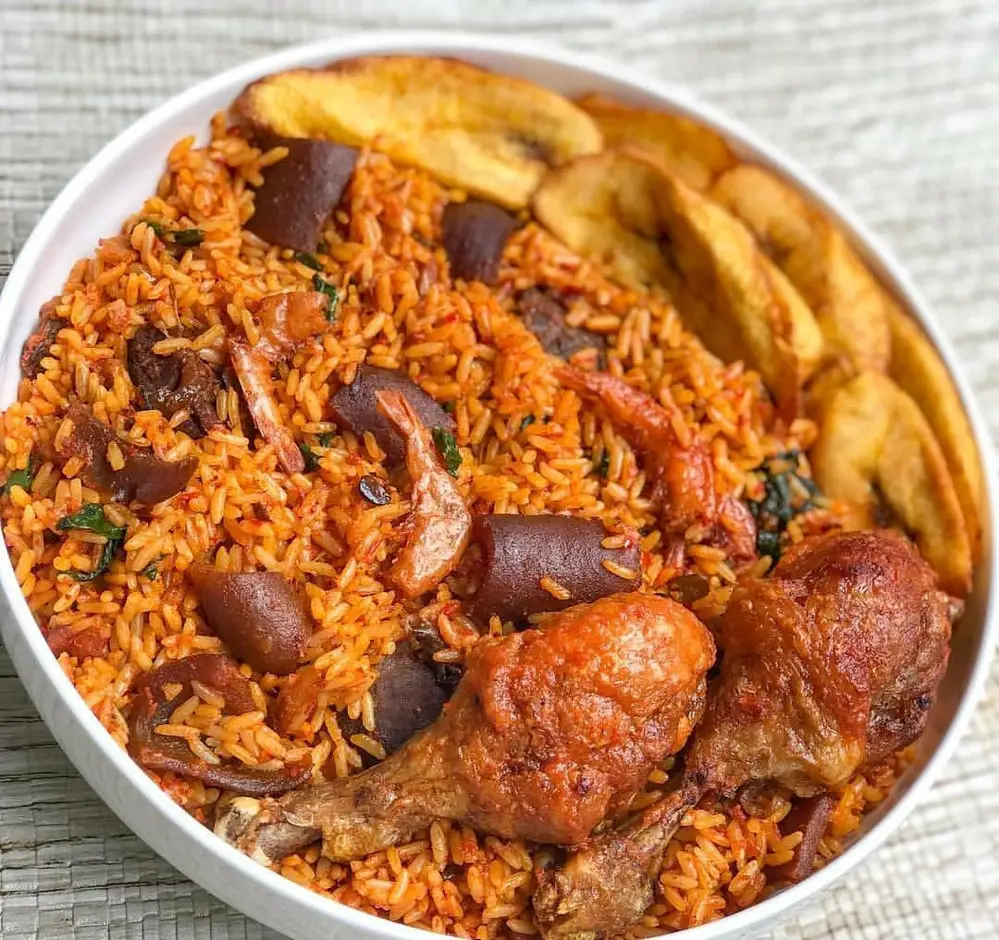
Jollof rice is undoubtedly Nigeria’s most popular staple cuisine. Jollof rice is popular throughout the country and is a popular menu item in both continental and local eateries.
It’s also a popular dish in Nigerian celebrations and events. Jollof rice is a combination of rice, tomato, pepper, and spices. Jollof rice is usually garnished with sweet corn, green peas, onions, and carrots to enhance its flavor.
The aromatic smell of Jollof rice is something to look forward to. A complete Jollof rice dish in Nigeria comprises fried plantains, coleslaw, moin-moin, and any preferred protein. Jollof rice is best enjoyed with chicken or turkey and a chilled carbonated beverage.
It’s safe to say that a Nigerian celebration would be incomplete without Jollof rice.
8. Tuwo Shinkafa
In Northern Nigeria, tuwo shinkafa is a common staple food. Tuwo is a thick pudding made from rice or rice flour. Tuwo is a thick pudding made from rice or rice flour.
Tuwo is made by mashing soft and sticky rice until it reaches a smooth consistency, then shaping dough balls from it. It’s generally served as a side dish with soups such as Miyan taushe, Egusi, Efo riro, and others.
This savory dish can be served on the same plate as your soup or on a separate plate. It is commonly eaten with hands and is commonly eaten at northern parties and celebrations. Tuwo is an alternative to swallow options like Pounded Yam(Iyan) and Eba (Cassava flour).
9. Ofada Rice
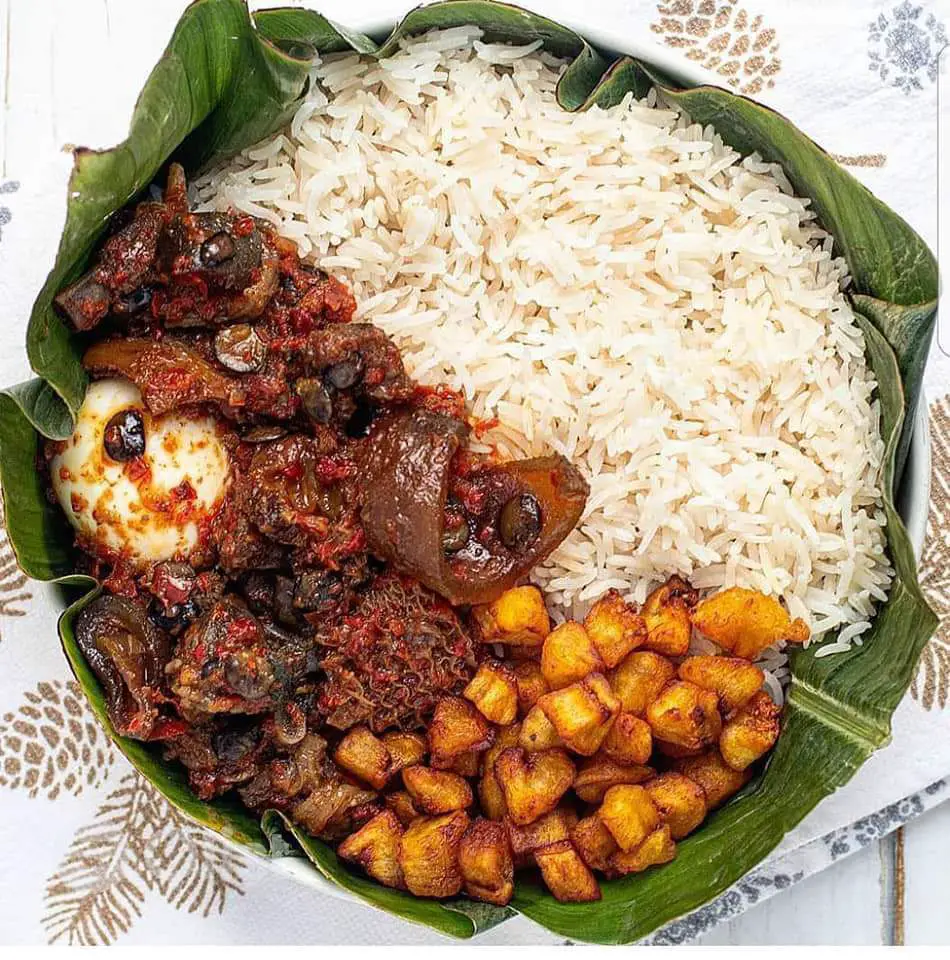
Ofada rice is an indigenous staple meal popular among Yoruba, particularly those from the Ogun State.
Ofada rice is served with sides such as beef, plantain, moin-moin, and stew-boiled eggs. Ofada rice is usually served on a local leaf. This local rice is best combined with a locally made stew also known as Ofada sauce.
This sauce is a blend of palm oil, locust beans, assorted meat, stock, crayfish, varieties of pepper, and seasoning cooked to taste. Ofada rice and sauce are highly nutritious. It is a popular food item in western Nigerian parties, events, and ceremonies, especially burial ceremonies.
10. Puff-puff (Fried Dough Balls)
In Nigeria, this is undoubtedly the most popular snack. Puff puffs are little deep-fried dough balls with a simple recipe. Flour, sugar, yeast, water, salt, and frying oil are used to make puff puffs.
As people have gotten more creative with adding other components like chocolate, different puff-puff recipes have arisen. Puff-puff can be eaten for breakfast, brunch, or lunch.
On a regular day in Nigeria, queues at puff-puff joints are not uncommon. Puff-puff tastes best when it’s soft and crunchy. To improve the sweetness of their fried dough balls, some people opt to coat them in sugar. This delectable nibble is also offered as desserts and appetizers at Nigerian gatherings and events. Puff puff is best served with a cold drink.
11. Egusi (Melon Soup)
The Egusi is a Nigerian soup made by the Igbo and Yoruba tribes. Ground melon seeds, palm oil, pepper, stock, and spice make up this sumptuous delicacy. Egusi soup is available in two variations: with and without vegetables. You’d be licking your fingers with any option.
Some Egusi recipes include melon ball lumps, while others are simply soup. In Nigerian homes, restaurants, and parties, egusi soup is a staple. It is best served with Iyan (pounded yam), Eba (cassava flour), or Semo.
12. Ewa Agayin (Mashed Bean With Sauce)
Ewa agayin is a common street treat native to western Nigeria. Ewa Agayin has probably been eaten by every Westerner in Nigeria.
When tourists visit Nigeria, Ewa agayin is frequently suggested since a trip to Nigeria is not complete without trying the spicy Ewagoyin. Ewa agayin is a dish made with mashed beans and a spicy sauce.
The ingredients for this sauce are pepper, tomato, onion, palm oil, and onions. Ewa agayin with your favorite drink is a fantastic combination that you will remember for a long time.
13. Asaro (Yam Porridge)
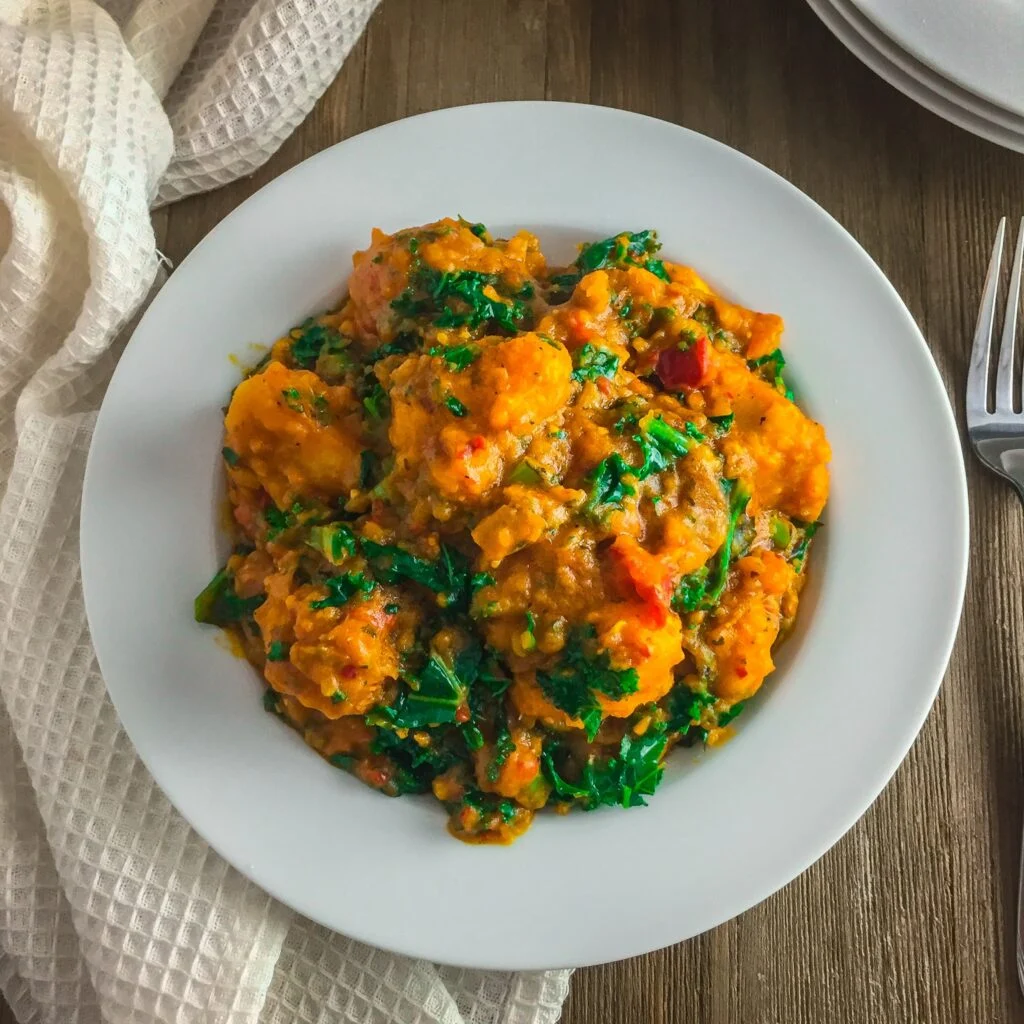
Asaro is a traditional Nigerian yam dish. Yam, scotch bonnet (rodo), bell pepper (tatashe), meat, stock, onion, palm oil, and spices are used to make Asaro. Before adding the remaining ingredients, the yam is sliced into medium-sized bits and boiled.
You can use a wooden ladle to break up the yam pieces once they’re tender, but not to purée them. Asaro is a quick and easy dish to prepare, taking about 45 minutes.
Assorted meats, fried fish, and vegetables are served as sides. Some believe Asaro to be Nigeria’s best yam dish.
14. Ogbono Soup
Because of its slimy texture, Ogbono soup is also known as draw soup in Nigeria. Ogbono soup is a traditional dish of the Igbo people of Eastern Nigeria, but it is also enjoyed by other tribes. Ground Ogbono soup, veggies, water, palm oil, varied meat or fish, stock, and flavor cubes make up Ogbono soup.
This concoction soup is simple to make and cooks in approximately an hour. Ogbono soup is a popular dish in African restaurants all over the world. Ogbono soup is best enjoyed with Fufu, Eba, or Semo.
15. Chinchin
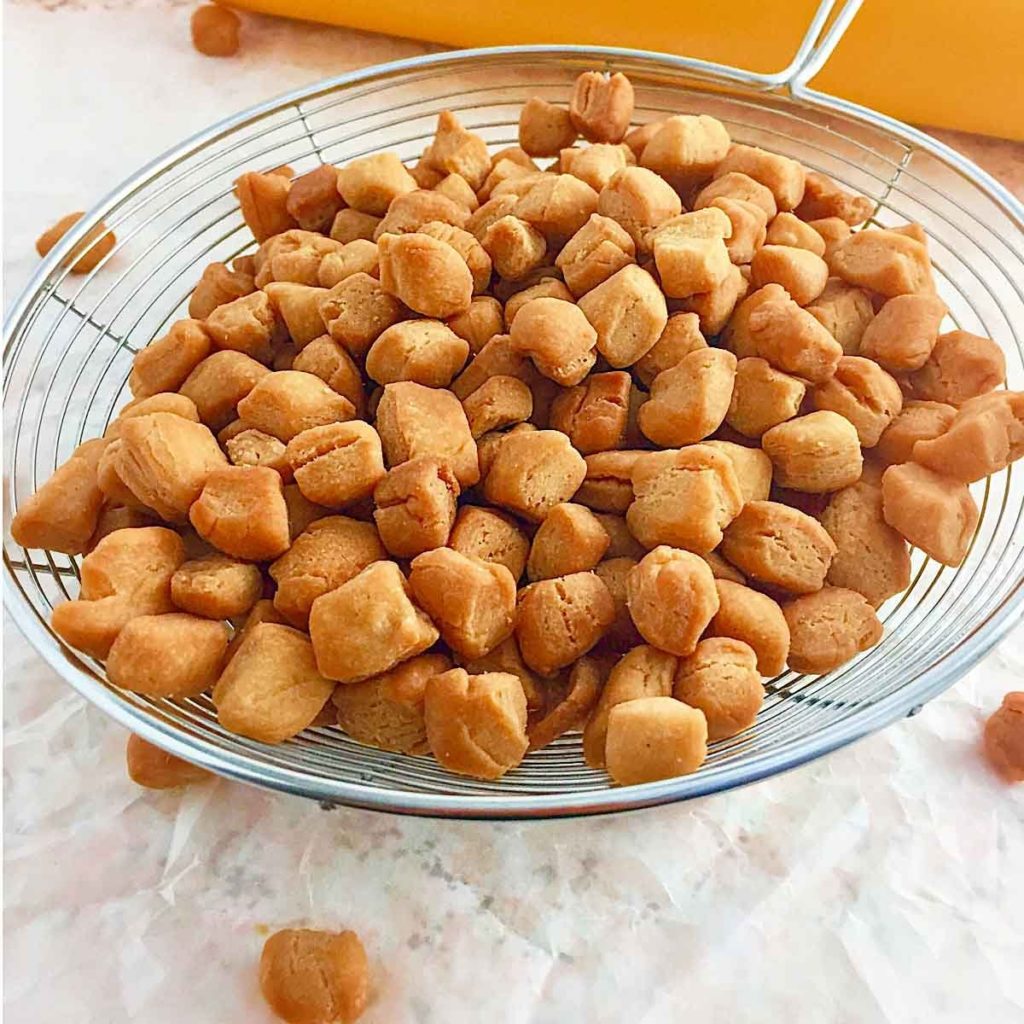
The crispy Chinchin is another tasty Nigerian delicacy. Flour, sugar, milk, butter, vegetable oil, eggs, and nutmeg are used to make Chinchin.
After that, the batter is cut into small and thin slices. It can be fried or baked, however, baked Chinchin is preferable. This famous dish is regularly cooked in Nigerian homes and offered as an appetizer to visiting guests.
In Nigerian festivals and ceremonies, it is also served as an appetizer. In recent times, Nigerians have come up with creative ways to enjoy the meal as it can now be prepared as a cereal meal mixed with milk and raisins.
16. Akara (Bean cake)
Akara is a popular Nigerian breakfast meal. Akara has a cultural significance in Western Nigeria because it is frequently the first meal offered to well-wishers and neighbors on the eve of burial ceremonies.
When warriors returned triumphant from battle in ancient Nigeria, Akara was cooked in large quantities as a symbol of victory. Akara is a blend of ground beans, pepper, salt, and seasoning cubes.
The bean paste is then scooped into balls and deep-fried. Akara is normally fluffy on the inside and crispy on the outside when cooked properly and at the optimum temperature. Akara is commonly eaten with bread, custard, or pap.
17. Pepper Soup
Pepper soup is a hot and spicy dish popular in Nigeria. Pepper soup is prepared with meat or fish chunks, chili peppers, scotch bonnet peppers, seasoning cubes, onions, ginger powder, and other spicy ingredients. Nigerians prepare pepper soup to keep warm during the winter months.
Pepper soup is also provided to people who have caught a cold or the flu. In local restaurants, pepper soup is a popular dish. It’s usually served with yam and rice. Pepper soup tastes best when served hot and with a cold beverage.
18. Nkwobi
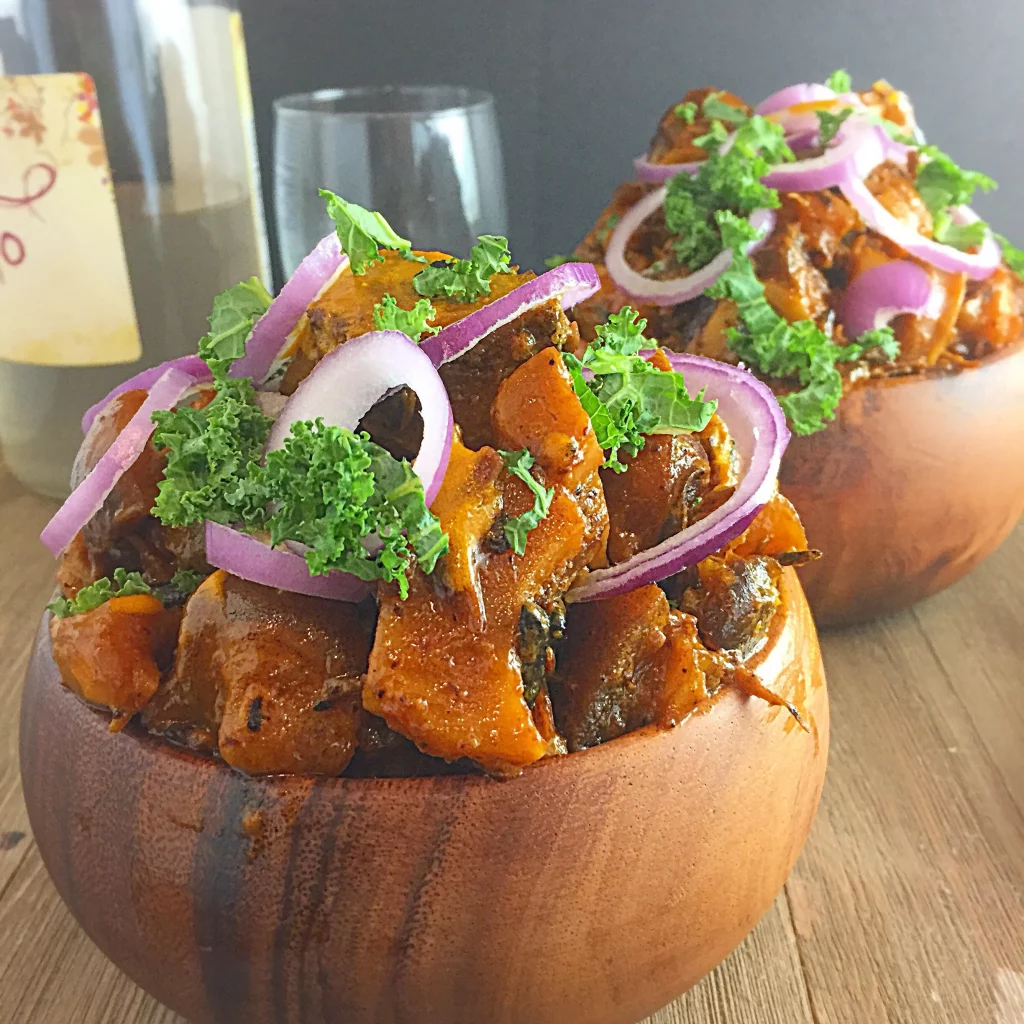
Nkwobi is a delicious cuisine that originated in Eastern Nigeria and is now served in many Nigerian eateries. Nkwobi is a cow leg soup, which means you can’t use any other meat. The main component in this meal is cow leg. Cow leg chunks, palm oil, potash, seasoning, and spicy condiments make up this dish.
Nkwobi is easy to make because all you have to do is boil the cow legs and then mix them into a blend of palm oil and potash. After that, you leave it to cook for around 5 minutes.
This spicy meal is best enjoyed with palm wine. Nkwobi is finger-licking good!
19. Beans and Dodo (Fried Plantain)
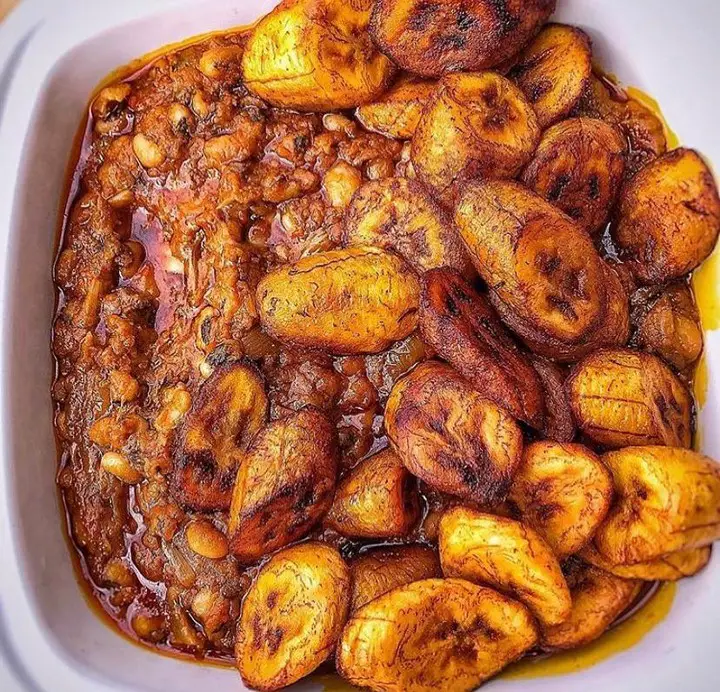
Beans and Dodo is a staple meal eaten across Nigeria. Beans and Dodo can be eaten any time of the day. Beans are made up of boiled beans, palm oil, salt, pepper, and seasoning cubes. Beans are high in protein and delicious. Dodo is made by either dicing, slicing, or cutting ripe plantains before frying them in vegetable or palm oil.
While well-cooked beans turn a rich brown color, properly fried Dodo turns a rich brown color. Beans and Dodo is a popular dish in local eateries. It can be garnished with stew, vegetables, meat, or fish, but it is best enjoyed with fried fish.
Beans and Dodo is a favorite amongst many Nigerians, especially westerners.
20. Suya (Spicy Grilled Kebab)
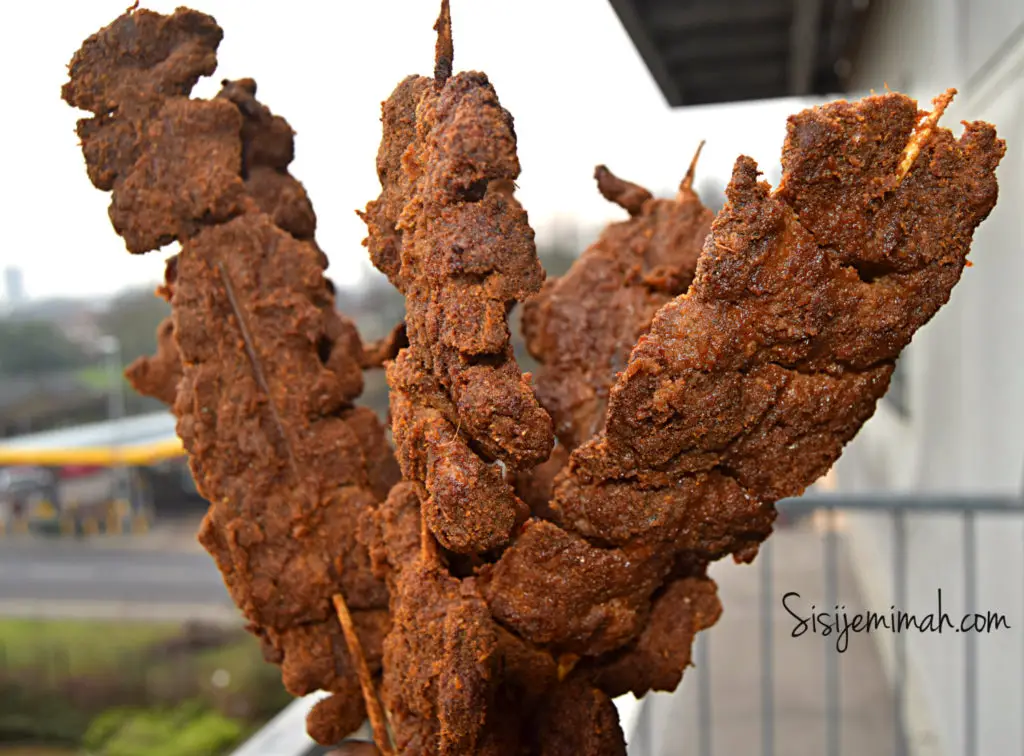
Suya is spicy skewered meat native to Northern Nigeria but consumed across the country. Almost every street in Nigeria has at least one suya joint.
Furthermore, almost every continental restaurant now has a Suya joint. They are only sold at night in Nigeria. Suya meat comes in three varieties: beef, fowl, and ram. The meat is marinated in spices before being barbecued to give it a peppery but tasty flavor.
Suya is typically served with onions, cucumbers, lettuce, and other innards such as kidneys and liver. They are served with small chops at Nigerian gatherings (puff-puff, samosa, and sausage rolls). Kilishi, on the other hand, is a much thinner and drier version of Suya. It’s a popular nighttime snack that’s best enjoyed with a cold beverage.
Final Note
Nigerian dishes top the list of most appetizing African cuisines. One of the main attractions for visitors visiting Nigeria is the delectable cuisine served in various parts of the country.
Nigerian food is highly nutritious and provides several health benefits. When Nigeria appears on your to-tour list, do well to try these meals. We cannot wait to have you share your mouth-watering experience.
Read next:
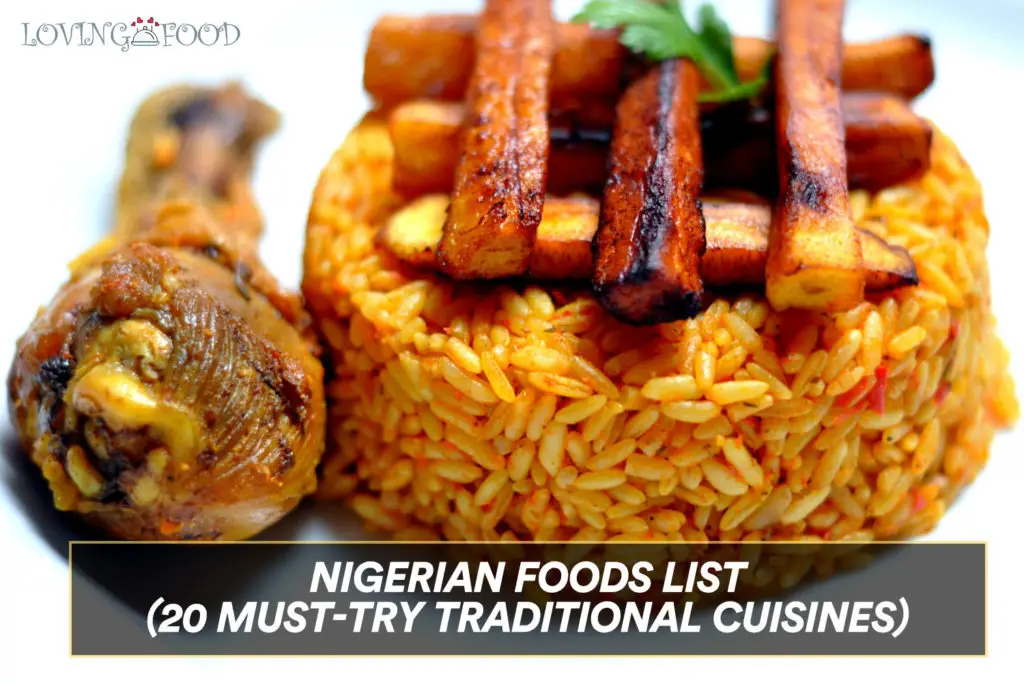

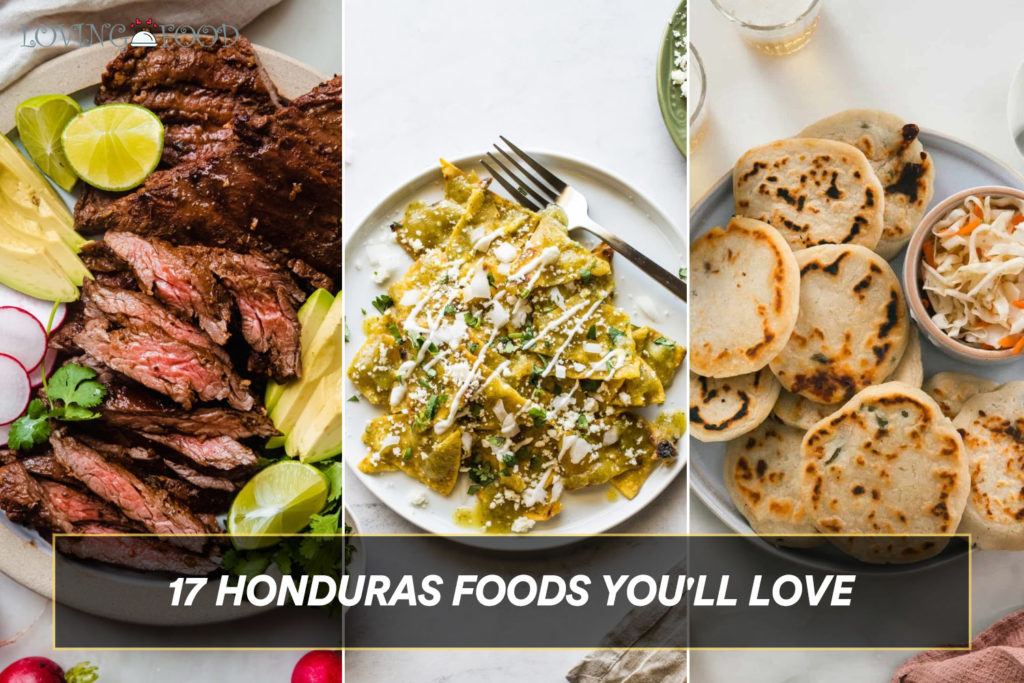
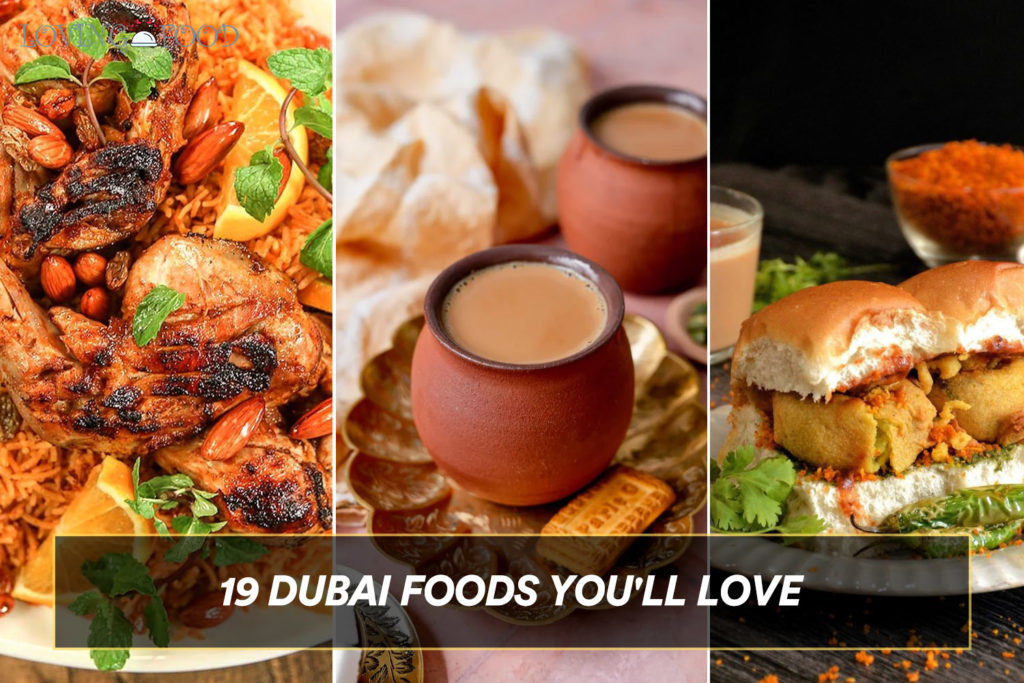
Comments are closed.